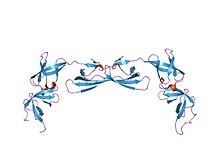| Elongation factor P (EF-P) KOW-like domain | |||||||||
|---|---|---|---|---|---|---|---|---|---|
 crystal structure of translation initiation factor 5a from pyrococcus horikoshii | |||||||||
| Identifiers | |||||||||
| Symbol | EFP_N | ||||||||
| Pfam | PF08207 | ||||||||
| Pfam clan | CL0107 | ||||||||
| InterPro | IPR013185 | ||||||||
| PROSITE | PDOC00981 | ||||||||
| |||||||||
| Elongation factor P (EF-P) OB domain | |||||||||
|---|---|---|---|---|---|---|---|---|---|
 crystal structure of translation elongation factor p from thermus thermophilus hb8 | |||||||||
| Identifiers | |||||||||
| Symbol | EFP | ||||||||
| Pfam | PF01132 | ||||||||
| Pfam clan | CL0021 | ||||||||
| InterPro | IPR001059 | ||||||||
| PROSITE | PDOC00981 | ||||||||
| CDD | cd04470 | ||||||||
| |||||||||
| Elongation factor P, C-terminal | |||||||||
|---|---|---|---|---|---|---|---|---|---|
 crystal structure of translation elongation factor p from thermus thermophilus hb8 | |||||||||
| Identifiers | |||||||||
| Symbol | Elong-fact-P_C | ||||||||
| Pfam | PF09285 | ||||||||
| InterPro | IPR015365 | ||||||||
| SCOP2 | 1ueb / SCOPe / SUPFAM | ||||||||
| CDD | cd05794 | ||||||||
| |||||||||
EF-P (elongation factor P) is an essential protein that in bacteria stimulates the formation of the first peptide bonds in protein synthesis.[1][2] Studies show that EF-P prevents ribosomes from stalling during the synthesis of proteins containing consecutive prolines.[1] EF-P binds to a site located between the binding site for the peptidyl tRNA (P site) and the exiting tRNA (E site). It spans both ribosomal subunits with its amino-terminal domain positioned adjacent to the aminoacyl acceptor stem and its carboxyl-terminal domain positioned next to the anticodon stem-loop of the P site-bound initiator tRNA.[3] The EF-P protein shape and size is very similar to a tRNA and interacts with the ribosome via the exit “E” site on the 30S subunit and the peptidyl-transferase center (PTC) of the 50S subunit.[4] EF-P is a translation aspect of an unknown function,[1] therefore It probably functions indirectly by altering the affinity of the ribosome for aminoacyl-tRNA, thus increasing their reactivity as acceptors for peptidyl transferase.
EF-P consists of three domains:
- An N-terminal KOW-like domain
- A central OB domain, which forms an oligonucleotide-binding (OB)-fold. It is not clear if this region is involved in binding nucleic acids[5]
- A C-terminal domain which adopts an OB-fold, with five beta-strands forming a beta-barrel in a Greek-key topology[5]
Eukaryotes and archaea lack EF-P. In these domains, a similar function is performed by the archaeo-eukaryotic initiation factor, a/eIF-5A, which exhibits some modest sequence and structural similarity with EF-P.[2][6] There are, however, important differences between EF-p and eIF-5A. (a) EF-P has a structure similar to that of L-shaped tRNA and it contains three (I,II and III) β-barrel domains. In contrast, eIF-5A contains only two domains (C and N) with a corresponding size difference.[2] (b) Moreover, as opposed to eIF-5A, which contains the non-proteinogenic amino acid hypusine that is essential for its activity, EF-P displays a diversity of post-transcriptional modifications at the analogous position (β-lysylation of lysine residue, rhamnosylation of arginine residue, or none at all).[7][8]
- ^ a b c Doerfel LK, Wohlgemuth I, Kothe C, Peske F, Urlaub H, Rodnina MV (January 2013). "EF-P is essential for rapid synthesis of proteins containing consecutive proline residues". Science. 339 (6115): 85–8. Bibcode:2013Sci...339...85D. doi:10.1126/science.1229017. hdl:11858/00-001M-0000-0010-8D55-5. PMID 23239624. S2CID 20153355.
- ^ a b c Hanawa-Suetsugu K, Sekine S, Sakai H, Hori-Takemoto C, Terada T, Unzai S, et al. (June 2004). "Crystal structure of elongation factor P from Thermus thermophilus HB8". Proceedings of the National Academy of Sciences of the United States of America. 101 (26): 9595–600. Bibcode:2004PNAS..101.9595H. doi:10.1073/pnas.0308667101. PMC 470720. PMID 15210970.
- ^ Blaha G, Stanley RE, Steitz TA (August 2009). "Formation of the first peptide bond: the structure of EF-P bound to the 70S ribosome". Science. 325 (5943): 966–70. Bibcode:2009Sci...325..966B. doi:10.1126/science.1175800. PMC 3296453. PMID 19696344.
- ^ Elgamal S, Katz A, Hersch SJ, Newsom D, White P, Navarre WW, Ibba M (August 2014). "EF-P dependent pauses integrate proximal and distal signals during translation". PLOS Genetics. 10 (8): e1004553. doi:10.1371/journal.pgen.1004553. PMC 4140641. PMID 25144653.
- ^ a b Hanawa-Suetsugu K, Sekine S, Sakai H, Hori-Takemoto C, Terada T, Unzai S, et al. (June 2004). "Crystal structure of elongation factor P from Thermus thermophilus HB8". Proceedings of the National Academy of Sciences of the United States of America. 101 (26): 9595–600. Bibcode:2004PNAS..101.9595H. doi:10.1073/pnas.0308667101. PMC 470720. PMID 15210970.
- ^ Rossi D, Kuroshu R, Zanelli CF, Valentini SR (2013). "eIF5A and EF-P: two unique translation factors are now traveling the same road". Wiley Interdisciplinary Reviews. RNA. 5 (2): 209–22. doi:10.1002/wrna.1211. PMID 24402910. S2CID 25447826.
- ^ Park JH, Johansson HE, Aoki H, Huang BX, Kim HY, Ganoza MC, Park MH (January 2012). "Post-translational modification by β-lysylation is required for activity of Escherichia coli elongation factor P (EF-P)". The Journal of Biological Chemistry. 287 (4): 2579–90. doi:10.1074/jbc.M111.309633. PMC 3268417. PMID 22128152.
- ^ Volkwein, Wolfram; Krafczyk, Ralph; Jagtap, Pravin Kumar Ankush; Parr, Marina; Mankina, Elena; Macošek, Jakub; Guo, Zhenghuan; Fürst, Maximilian Josef Ludwig Johannes; Pfab, Miriam; Frishman, Dmitrij; Hennig, Janosch; Jung, Kirsten; Lassak, Jürgen (24 May 2019). "Switching the Post-translational Modification of Translation Elongation Factor EF-P". Frontiers in Microbiology. 10: 1148. doi:10.3389/fmicb.2019.01148. PMC 6544042. PMID 31178848.